Many people believe that watch accuracy can be achieved by simply adjusting the regulator screw towards the + or – position.
Regulating a watch is a lot more complex than this. Watches that are inaccurate are inaccurate for a reason.
Generally, these watches require cleaning and conditioning (oiling and greasing of the winding mechanisms).
Conditioning also means ensuring that all of the train wheels are free from obstruction, the hairspring is centered and the last coil of the hairspring moves freely between the regulator pins.
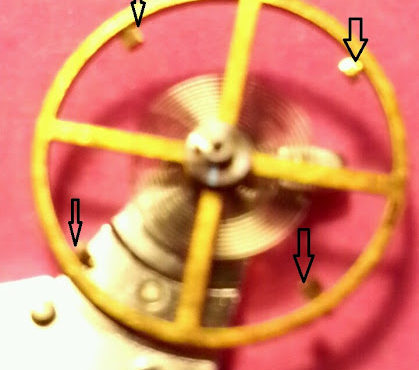
After the above conditions are met, then you can proceed with regulating the watch. The key is to never try to regulate a dirty watch!
Regulating a mechanical watch means making it run slightly faster or slower by making a small change in the length of the balance hairspring. The shorter the length, the quicker the balance completes its swing and so the watch runs faster.
If the length is made greater, the opposite occurs. This change is made by moving the regulator.
Regulator, Regulator Screw on a Hamilton 992B
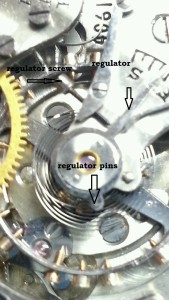
Regulation is done on this Hamilton by carefully turning the regulator screw in or out to adjust the length of the hairspring which will slow down or speed up the timing.
This seems like a simple project. Just get a screwdriver, turn the screw and you are finished. The problem is that if you slip, your screwdriver goes right into the heart of your watch and you will probably ruin the hairspring, break the balance staff or both.
I get lots of watches every year that are ruined by someone trying to make a little “adjustment” and then they cause a huge problem.
A Standard Mans Watch Showing the Regulator
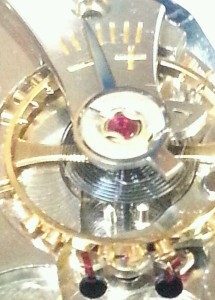
How to Regulate a Rolex
Regulating a Rolex is totally different than on a standard watch. A Rolex is not adjusted by changing the length of the hairspring.
The spring length is locked in place, you change the timing by adjusting the weight of the balance wheel. Modern Rolex watches have either two or four regulator screws on the balance wheel.
In order to adjust the time, the screws are turned in (makes the watch run faster) or turned out (makes it run slower). Think of a figure skater doing a spin.
When they start to spin, if they pull their arms in, they spin faster. If they extend their arms out, they slow down. The same principle applies here.
The screws are turned by a special wrench that exactly matches the head of the screw. This is quite a fine job to do, you need both hands and a lot of practice.
I always remove the balance wheel from the watch to adjust the screws. Trying to do it when the balance is in the movement is tricky, dangerous and a great way to break a balance staff.
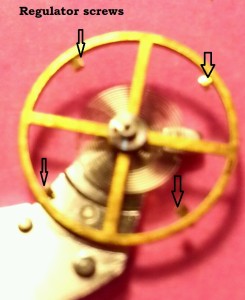
Picture of the Regulator Wrench
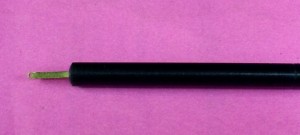
Words of wisdom from Clint Eastwood

Please keep in mind that just because you have a screwdriver and a case opener, you should never try and regulate your watch.
I tell customers very simply that I don’t know anything about cars and would never even think of trying to change the oil in my car. Please use that same logic with your watch. Don’t ever open the case back or try and make any adjustments without lots of training, the proper tools and timing equipment.
Please try and “know your own limitations!”

PHOTO OF THE WEEK: I had a nice visit from my friend and customer Mick Brown this week. He is a Master Falconer and brought up two of his birds, a Harris Hawk and a Screech Owl. Both birds were amazing. He also made a trip to our high school to show his birds to the high school science class. Another interesting customer at the watch shop!


